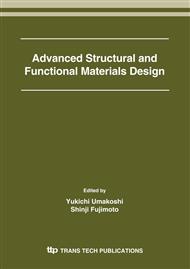p.331
p.337
p.343
p.349
p.355
p.361
p.367
p.373
p.379
Interfacial Microstructure and Joint Strength of Sn-Ag and Sn-Ag-Cu Lead Free Solders Reflowed on Cu/Ni-P/Au Metallization
Abstract:
Sn-3.5Ag (Sn-Ag) and Sn-3.5Ag-0.75Cu (Sn-Ag-Cu) solder balls were reflowed on electroless Ni-P/Au plated Cu pad with varying thickness of Au layer (0 to 500nm). In the Sn-Ag solder joint, a P-rich layer including voids, which resulted from Ni diffusion from the Ni-P plating to form Ni3Sn4 interfacial reaction layer, formed at the interface regardless of Au plating thickness. This caused the degradation of the joint strength. On the contrary, the Sn-Ag-Cu solder joint had no continuous P-rich layer formed and showed a higher joint strength than the Sn-Ag solder joint in the case of Au plating of 50nm or less. Cu alloying to the solder promote the formation of (Cu, Ni)6Sn5 instead to Ni3Sn4 as the interfacial reaction layer. The (Cu, Ni)6Sn5 reaction layer can suppress the diffusion of Ni from the N-P plating and thereby inhibit the formation of the P-rich layer. However, in the case of thick Au plating of 250nm or more, a thin P-rich layer formed at the interface even in the Sn-Ag-Cu solder joint and the joint strength was degraded. Au dissolving into the solder from the Au plating during the reflow process may encourage the diffusion of Ni from the Ni-P plating into the solder. As a result, the Sn-Ag-Cu solder joints with 50nm Au coating provided the best joint strength, although its joint strength considerably degraded after the aging treatment at 423K.
Info:
Periodical:
Pages:
355-360
Citation:
Online since:
April 2006
Price:
Сopyright:
© 2006 Trans Tech Publications Ltd. All Rights Reserved
Share:
Citation:


